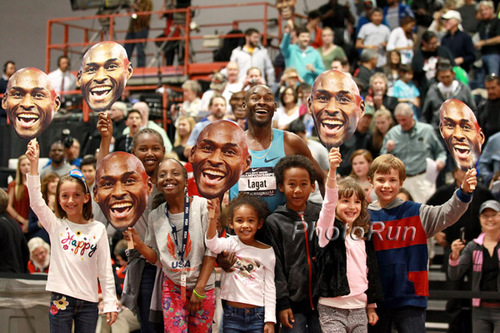2014 USA Indoor Track & Field Championships
USA Indoors: Day Two
Current Observations May Be Clues To Future Performances
February 22, 2014
Albuquerque, New Mexico
When performed indoors, track & field is simply a more compact and intimate presentation of the grander and more “old school” version of the sport we love. Just like championship golf is played on courses of varying distances and dissimilar terrain, and world class tennis is competed on a variety of different surfaces, track & field can also be compelling in both indoor  and outdoor venues. But indoor competitions – because of its differing events, track sizes, and its placement on the calendar – can also be a harbinger of future athletic performances when the sport moves outdoors and onto the bigger oval and the more spacious field.
and outdoor venues. But indoor competitions – because of its differing events, track sizes, and its placement on the calendar – can also be a harbinger of future athletic performances when the sport moves outdoors and onto the bigger oval and the more spacious field.
The primary focus of the 2014 USA Indoor Track & Field Championships is, of course, to determine national champions in all of the indoor events and to select the best-performing athletes to represent the United States in the World Indoor Championships next month in Sopot, Poland. But this indoor meet can also offer useful information and subtle clues about the competitors themselves: Who is in top flight, competitive shape? Has that lingering hamstring injury fully healed? How is that experimentation progressing with different events, with a different run up, with a new starting block configuration? It was at this very meet two years ago that Aries Merritt’s experimentation with 7 steps finally clicked. His 2012 indoor championship hurdle victory here was the start of his inexorable march to Olympic gold and his stunning, picture-perfect outdoor world record run of 12.80 on a windless, season-ending night in Brussels.
So on Day Two – primarily a day of qualifying with only a few finals – what can we observe that might give us insight on an upcoming outdoor season devoid of any global championship?
Jenay Deloach Soukup – coming off a sparkling Millrose victory in the hurdles last weekend – looks to be in mid-season form. Stepping back from the long jump to “give my body a rest”, the Olympic bronze medalist in the long jump looks ready to be competitive in what really is her secondary event.
Gray Horn – the beneficiary of a very good cycle of multi training this fall in southern California – looked razor sharp in capturing the heptathlon title. His PR point total of 6071 – a 100 point improvement over his previous best score – is the American leader and resulted in his first national championship. His multi victory – spiced with indoor personal best clearances in the high jump [2.07m / 6’9½”] and the pole vault [4.90m / 16’¾”] – prompt upbeat speculation about what kind of decathlon numbers he might be able to throw up when the sport moves outdoors.
A.G. Kruger’s win in the weight throw – his 8th indoor national title – signals he is ready to continue to fend off both competitors who challenge his U.S. dominance and Father Time. The 35 year-old’s winning heave of 23.70m [77’9¼”] won the event by over two feet and sent the message that his reign as the premier U.S weight/hammer athlete is far from over.
In the men’s long jump final, a battle between two Chula Vista Elite athletes might suggest they are ready to push the old guard in the horizontal leap. Tyron Stewart – cruising along after 5 rounds with a leading jump of 8.07m- saw his lead vanish when teammate Chris Benard uncorked a leap of 8.08m [26’6¼”]. But Stewart was not done. On his final attempt, he dug deep to stretch out 8.22m [26’11¾”] to seal the win. Might this duo be ready for prime time?
American leader Gwen Berry could not top her year-leading weight throw of 24.39m [80’½”] set earlier this year. But her toss of 23.82m [78’1¾”] was good enough to better runner-up Amber Campbell who finished second with a best mark of 23.68 [77’8¼”]. The field should be wide open later this year when the American throwers move outside to the hammer.
Mark Hollis captured the national crown in the men’s pole vault with a winning vault of 5.55m [18’2½”] . But his three unsuccessful attempts at 5.75m [18’10¾”] leaves him without a world qualifying mark – and no ticket to Poland. “This has been my best indoor season ever,” offered last week’s Millrose winner. “I really had sights on winning today and making that “A” standard. But I just didn’t have quite the consistency at the standard that I needed.” The new national indoor vault champion will find plenty of domestic competition during the outdoor season.
Erik Kynard was in control throughout in the men’s high jump final. His second attempt clearance at 2.30m [7’6½”] was enough to turn back Darius Purcell – second with a top bar of 2.27m [7’5¼”] – and the rest of the field. “I think I’m on track,” the winner declared. “I think I’ve been training and progressing well indoors. I think I am on track to do some special things. I am just focusing on doing things correctly, staying healthy, and sticking to the script.” The reigning Olympic silver medalist is all prepared for the competition in Poland – and for his real battles which will come later in the year: Diamond League showdowns with Bohdan Bondarenko, Derek Drouin, and Mustaz Barshim.
The premier track finals on Day Two were the 3000’s. What clues would they offer? In Kim Conley’s absence, who might step up in a talented women’s field to grab a national title? Would Galen Rupp overcome the hip issues that plagued him earlier this month in Boston to tangle with the ageless Bernard Lagat – who looked invincible in setting an American Record in the 2000 last week at the Millrose Games?
In the women’s 3000, championship tactics combined with respect for the altitude to produce a dawdling opening pace. Laura Thweatt led a bunched field of 16 through the opening laps. The pace quickened slightly at one kilometer as Jordan Hasay tucked in behind Thweatt who continued to set the pace. As circuits dipped down to the mid-30’s, Sara Vaughn bolted into the lead with 500 remaining – a move that was quickly covered by Shannon Rowbury, Gabe Grunewald, and Hasay. With 300 remaining Grunewald – in full flight – made a drive for the lead. Some jostling occurred at the bell which untangled with Grunewald in front and pulling away. The Brooks athlete – who covered the final 400 in a hand-time 62 seconds – stormed around the final circuit unchallenged to finish first in 9:23.15 – comfortably ahead of Rowbury who finished second in 9:25.49. Final results were stalled as a protest was lodged. The protest – alleging the winner had impeded Hasay at the bell – was ultimately denied.
20 elite middle distance men answered the gun in the men’s 3000. Unlike the women’s 3000, the men got right after it with Andrew Bumbalough cranking out 30 second laps up front. As the field strung out, a quintet emerged shortly after one kilo to pull away. Shortly after Bumbalough led Ryan Hill, Lopez Lomong, Galen Rupp, and Bernard Lagat through two kilos in 5:13, Hill grabbed the lead, quickened the pace, and the real race was on. Hill – his move covered by the other four racers – soon ceded the lead to Rupp who went to the front with 600 remaining. Lagat – the defending world indoor 3000 champion – never flinched. Lagat stalked Rupp before opening it up with 300 remaining. All alone on the final circuit and dodging lapped runners, the ageless one cloc
ked 27 flat for the final 200 to win going away – stopping the clock at 7:46.01.
In the mixed zone, Rupp – the runner up in 7:48.19 – shared his thoughts on the race. “I knew it would come down to a kick whether it was fast or slow. The guys made it honest so I just tucked in,” explained Rupp. “I was happy to see it go out a little bit harder because my strength is great right now. The finish was hard. I stayed calm, adjusted my speed, and I was able to get my spot [on the national team to Poland.]
The 3000 meter champion – surrounded in the mixed zone by his children and other youngsters – was upbeat with the media. “It happened perfectly in the middle of the race – the chance to keep my eye on the others,” offered Lagat. “I just wanted to stay relaxed. With two laps to go, I was feeling really great. I wanted to watch for Galen who is capable of running hard, of going all out. And when he made a move, he made a good move, but not a move that was too hard for me. So I wanted to stay next to him until there was 300 to go and then go all out without looking back. And that’s what I did.”
The national titles that will be captured here this weekend should be – and will be – celebrated. And when the meet concludes here on Sunday, there is every reason to believe that the U.S. will have assembled a team that will prove to be a very competitive force in the world indoor championships next month in Poland. But the flashes of brilliance witnessed here also suggest that even in a year without an outdoor global championship, the warm weather season will likely serve up many sterling track & field performances to savor.
~Dave Hunter




















